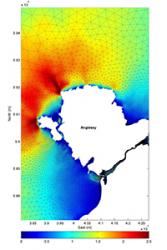Scientists predict sea states for renewable energy
 A computer simulation predicting tidal currents around Anglesey.Tidal and wave technology is finally coming of age and the UK leads the world in the development of this vital renewable energy resource. �鶹��ý����� is playing a crucial role in this: as the industry moves towards large-scale commercialisation, experts at the University’s are working to maximise the operational efficiencies of energy-generating devices.
A computer simulation predicting tidal currents around Anglesey.Tidal and wave technology is finally coming of age and the UK leads the world in the development of this vital renewable energy resource. �鶹��ý����� is playing a crucial role in this: as the industry moves towards large-scale commercialisation, experts at the University’s are working to maximise the operational efficiencies of energy-generating devices.
Wave and tidal devices are designed to generate the optimum amount of power within specific environmental ranges. Bangor scientists are providing state of the art expertise and facilities to companies through the , an initiative part funded by the Welsh European Funding Office, part of the Welsh Government. Their computer models accurately predict tidal currents, wave heights and other important measurements throughout the water column, helping to identify the best sea states, tidal flows and accessibility for wave and tidal devices, and to test the behaviour of prototypes and commercial scale turbines.
“Initial work has shown companies how devices might operate at normal and extreme sea states in different locations,” explains Dr. Reza Hashemi, SEACAMS modeller at the School of Ocean Sciences.
Siemens-owned Marine Current Turbines (MCT) is developing large scale tidal current energy generation technology and is set to deliver the first tidal energy converters in the UK. Its SeaGen tidal energy converters are to be used in the Skerries off the North West Coast of Anglesey with consent in place for an array of up to 10MW installed capacity. MCT has worked with the SEACAMS modelling team to understand the best sites for future development of marine energy farms.
“Hydrodynamic modelling is a valuable way to rapidly identify the best sites to deliver the optimum performance from our tidal energy converters by understanding more about the changing physical environment they will be operating in over long time periods,” reports Dr Scott Couch, MCT Principal Resource Analyst.
Numerical models are complex and require large quantities of processing power, as well as modelling expertise, which is often beyond the capability or affordability of a commercial SME. The SEACAMS programme gives companies funded access to these resources.
“Our developing 3-d models will predict variation in water velocity throughout the column, which will influence the way the devices are positioned, and will also model the impact devices will have on the surrounding environment,” reflects Reza.
“It is fundamental that we have the best possible understanding of the environment our devices will be operating in. SEACAMS is providing the step change in the modelling capability required to accelerate the development of our industry,” reflects Scott.
“This important sector is moving from being a developing technology to commercial viability and will be able to deliver significant clean energy for the UK. It’s important that these technologies are supported through development and early commercial testing to build market confidence and investment. Many of the players in this market are small and medium enterprises and the type of research support and academic expertise offered by the SEACAMS programme is very welcome in creating confidence in the technology and its bank-ability,” concludes Dr Stephanie Merry, Head of Marine at Renewable Energy Association.
Publication date: 11 December 2013
